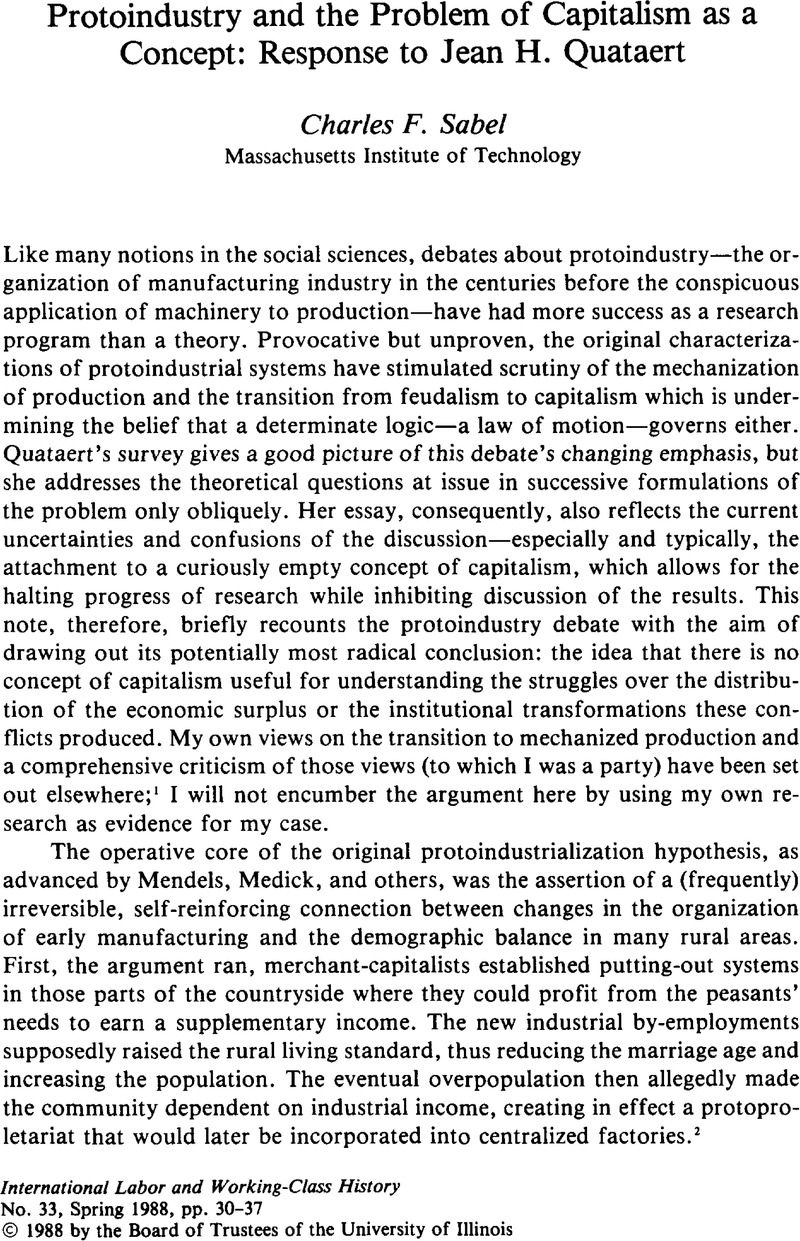Published online by Cambridge University Press: 16 December 2008

1. Sabel, Charles F. and Zeitlin, Jonathan, “Historical Alternatives to Mass Production: Politics, Markets and Technology in Nineteenth-Century Industrialization,” Past and Present 108 (08 1985): 133–76CrossRefGoogle Scholar; Sabel, Charles F. and Zeitlin, Jonathan, “Report of the Groupe de travail internationale sur les alternatives historique a la production de masse,” MSH Informations 54 (1987): 24–27.Google Scholar For a parallel discussion of the issues discussed here, see Unger, Roberto M., Social Theory: Its Situation and Its Task (Cambridge, 1987), 101–17.Google Scholar For criticism of Sabel/Zeitlin, see “Groupe de travail,” 24–27.
2. See, for example, Mendels, Franklin, “Proto-Industrialization: The First Phase of the Industrialization Process,” The Journal of Economic History 32 (1972): 241–61CrossRefGoogle Scholar; Kriedte, Peter, Medick, Hans, and Schlumbohm, Jurgen, trans. Schempp, Beate, Industrialization before Industrialization: Rural Industry in the Genesis of Capitalism (Cambridge, 1981).Google Scholar
3. See her discussion of Japan and the Caux.
4. Gutman, Myron P. and Leboutte, Rene, “Rethinking Protoindustrialization and the Family,” Journal of Interdisciplinary History 14 (Winter 1984): 605.Google Scholar
5. Hudson, Pat, “Proto-industrialization: The Case of the West Riding Wool Textile Industry in the 18th and Early 19th Centuries,” History Workshop 12 (1981): 34–61CrossRefGoogle Scholar; Hudson, , “From Manor to Mill: The West Riding in Transition,” in Manufacture in Town and Country Before the Factory, ed. Berg, Maxine et al. (Cambridge, 1983).Google Scholar
6. Gutman, and Leboutte, , “Rethinking Protoindustrialization,” 604–5.Google Scholar
7. Coleman, D. C., “Proto-Industrialization: A Concept too Many,” Economic History Review, second series, 36 (1983): 435–48.CrossRefGoogle Scholar
8. See Bourdieu, Pierre, Outline of a Theory of Praxis, trans. Nice, Richard (Cambridge, 1977).CrossRefGoogle Scholar
9. Medick, Hans, “Pivilegiertes Handelskapital und ‘Kleine Industrie.’ Produktion und Produktionsverhaeltnisse im Leinengewerbe des altwuerttembergischen Oberants Urach im 18 Jahrhundert,” Archiv für Sozialgeschichte 23 (1983): 267–310, 269.Google Scholar
10. For the most recently and comprehensively, Brenner, Robert, “The Agrarian Roots of European Capitalism,” in The Brenner Debate, ed. Aston, T. H. and Philpin, C. H. E. (Cambridge, 1985), 213–327.CrossRefGoogle Scholar
11. Medick, , “Pivilegiertes,” 267–69; 309–10.Google Scholar
12. Levy-Leboyer, Maurice, Les banques europeenes et L'industrialisation internationale dans la première moitié du XIXe siecle (Paris, 1964)Google Scholar; O'Brien, Patrick and Keydar, Caglar, Economic Growth in France and Britain, 1780–1914: Two Paths to the Twentieth Century (London, 1978)Google Scholar; Aymard, Maurice, “La transizione dal feudalismo al capitalismo,” in Storia d'Italia, Annali 1, ed. Romano, Ruggiero and Vivanti, Corrado, (Turin, 1978): 1131–92Google Scholar; Dewerpe, Alain, L'industrie aux champs, Essai sur la protoindustrialisation en Italie du Nord (1800–1880) (Rome, 1985)Google Scholar; Braun, Rudolf, Industrialisierung und Volksleben. Die Veraenderungen der Lebensformen in einem Laendlichen Industriegebiet vor 1800 (Zuericher Oberland) (Erlenbach-Zuerich, 1960)Google Scholar; Veyrassat, Beatrice, Negociants et fabricants dans L'industrie cotonière suisse, 1760–1840. Aux origines financieres de L'industrialisation (Lausanne, 1982).Google Scholar
13. See, for example, O'brien, and Keydar, , Economic Growth in France, 146–84.Google Scholar
14. Bois, Guy, “Against the Neo-Malthusian Orthodoxy,” in The Brenner Debate, ed. Aston, and Philpin, , 107–18.Google Scholar
15. Medick, , “Pivilegiertes,” 310.Google Scholar
16. For further discussion of these possibilities, see Sabel, Charles F. “Changing Models of Economic Efficiency and their Implications for Industrialization in the Third World,” in Development Democracy and the Art of Trespassing: Essays in Honor of Albert O. Hirschman, ed. Foxley, Alejandro et al. (Notre Dame, 1986), 27–55.Google Scholar
17. See Triglia, Carlo, Strategie de flessibilita: imprenditori, sindacati e governo locale. Il caso di Prato,” paper prepared for the project “Strategies for Flexibility: Corporations, Unions, and Local Governments, ” directed by Regini, Marino and Sabel, Charles, 09 1987.Google Scholar